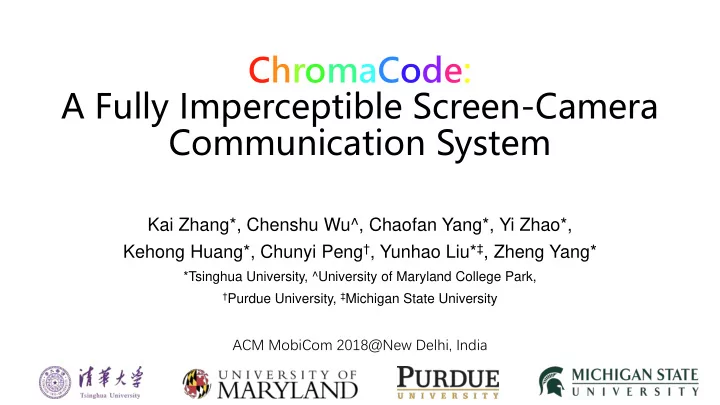

ChromaCode: A Fully Imperceptible Screen-Camera Communication System Kai Zhang*, Chenshu Wu^, Chaofan Yang*, Yi Zhao*, Kehong Huang*, Chunyi Peng † , Yunhao Liu* ‡ , Zheng Yang* *Tsinghua University, ^University of Maryland College Park, † Purdue University, ‡ Michigan State University ACM MobiCom 2018@New Delhi, India
Simultaneous Viewing and Communication 65% of people skip online video ads, QR code embeds extra info, yet mainly due to the intrusiveness still affects viewing experience Making ads and other info invisible to viewers?
Hidden Screen-Camera Channel Embed data into high frame rate primary videos unobtrusively Flicker-fusion property High capture rate
Related Works • InFrame, InFrame++ • ImplicitCode • HiLight InFrame, InFrame++ • TextureCode • Uber-in-Light TextureCode
Three Conflicting Key Goals Three key goals on imperceptible, high rate, and reliable Reliability communication are desirable but conflicting. Previous works usually made a trade-off among them. ChromaCode achieves all three goals while retaining watching experience to users. Invisibility
Overview ChromaCode overall architecture
Hidden Screen-Camera Channel Hiding data frame from human eyes is achieved by complementary lightness modification. V+D V Flicker fused D V-D Both captured Complementary frames But the hiding quality is not good enough in related works.
Color space preliminaries Color spaces are models for human vision system. CIERGB color space was built from human eyes experiments. CIERGB has chromaticity distributions in negative axis. Experiment to build RGB Three kinds of cone cells in CIERGB chromaticity space human eyes color space
Color space preliminaries CIEXYZ chromaticity space MacAdam ellipses on CIEXYZ CIEXYZ color space was built by MacAdam ellipses prove CIERGB, linear transforming CIERGB CIEXYZ and all their linear color space. transformations non-uniform .
Achieving Fully-Imperceptible Color space selection Hue and lightness palettes in non-uniform color space Hue and lightness palettes in uniform color space While color differences are not obvious here. Color differences are more perceptively uniform ! Uniform color spaces suit human vision system better. Therefore we choose uniform color spaces . Color differences are obvious here.
Achieving Fully-Imperceptible Spatially Adaptive Embedding Outcome-based Lightness Change Derivation: Texture-based Lightness Change Adaptation: Our solution: CIELAB uniform color space with Decrease lightness change in smooth regions CIEDE2000 formula (the latest and most accurate where flicker is more noticeable: color difference formula): ∗ i, j = 𝑙 𝑀 1 + 0.015 𝑀 ∗ (i, j) − 50 2 Δ𝑀 1 20 + 𝑀 ∗ (i, j) − 50 2 Δ𝐹 00 Texture_complexity i, j Desired lightness changes Expected color difference Lightness changes are Lightness changes are ∗ i, j = Final lightness change: Δ𝑀 2 more noticeable in less noticeable in ∗ i, j × (Texture_complexity i, j ) Δ𝑀 1 smooth regions textured regions
Achieving Reliable High Throughput Challenges: Projection distortion Moiré pattern Rolling shutter effect
Achieving Reliable High Throughput Error correction code scheme: Reed- Full-frame embedding Solomon code + convolutional code One cell encoding one bit Interleaving to deal with burst errors Eliminate various channel distortions
Evaluation • User study: participants give scores for invisibility • Data transmission: measure raw throughput, data goodput and BER Representative primary video clips and tags used in the experiments
Evaluation Impact of video sources and color space Videos with higher texture complexity CIELAB uniform color space indeed usually achieve better invisibility, but yields significantly better invisibility also lower raw throughput (T_Raw) than the other color spaces, without and data goodput (G_Data), and downgrading the data transmission higher BER. performance
Evaluation Impact of distance and angle Invisibility is better under larger distance, But throughput and BER get worse under larger distance or angle. Larger data cell sizes or screen sizes will improve data transmission performance over long distances.
Evaluation Comparative Study ChromaCode achieves superior performance over previous schemes in terms of invisibility, throughput and BER.
Conclusion • We present ChromaCode, a system that achieves all three goals on unobtrusive, high-rate, reliable screen-camera communication. • We prototype ChromaCode and evaluate it by experiments. The results demonstrate its superior performance over previous schemes in terms of invisibility, throughput and BER.
Thanks! For more information, please refer to our ACM MobiCom’18 paper.
Evaluation Energy consumption and Encoding/Decoding speed Energy consumption (W) • The more powerful Pixel 2 achieves faster decoding speed, but also has higher energy consumption. • Distinction between Nexus 6P and Pixel 2 on energy Encoding/Decoding speed (fps) consumption distribution is observed.
Recommend
More recommend